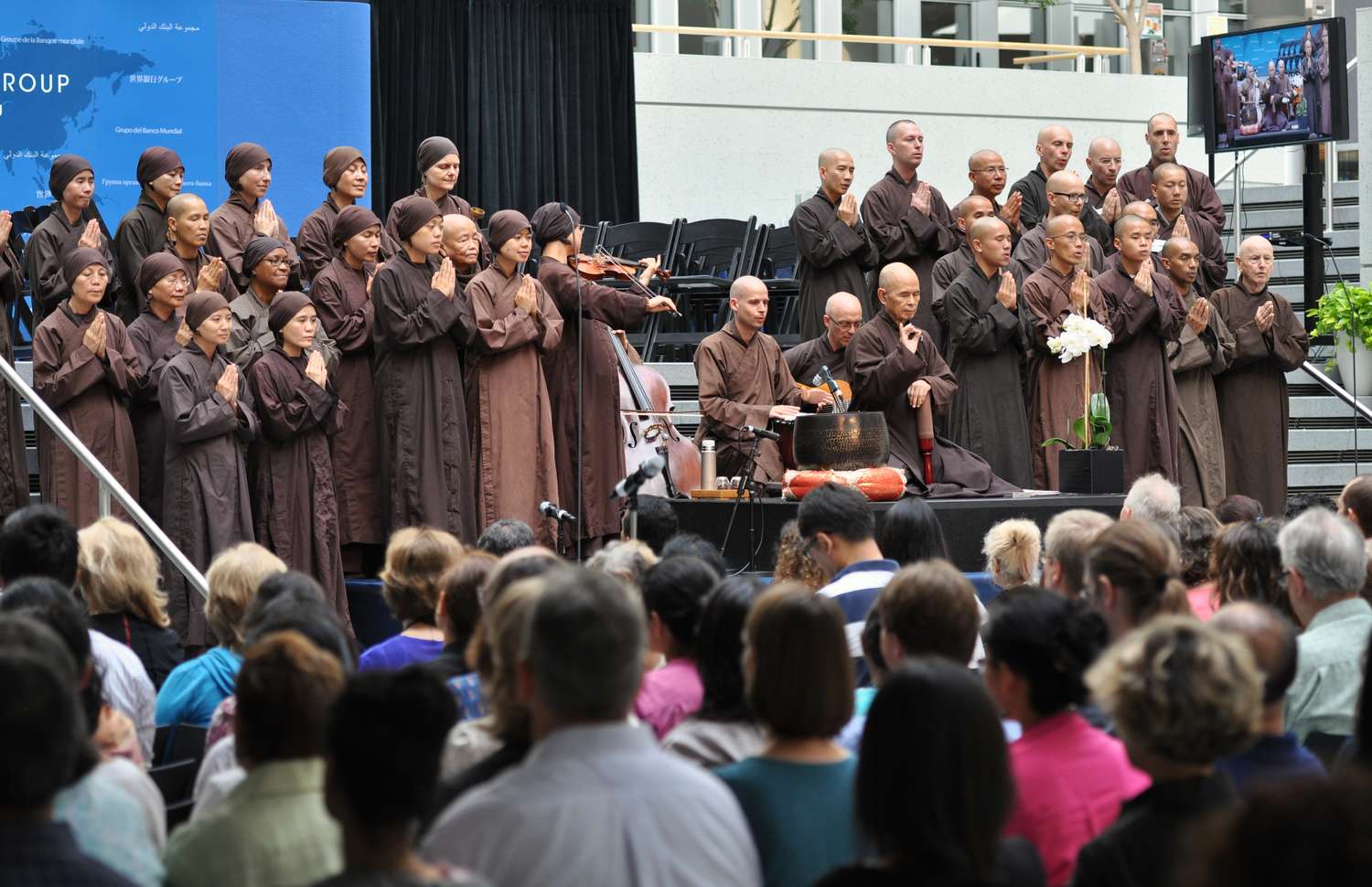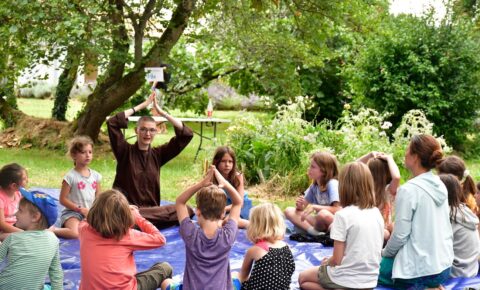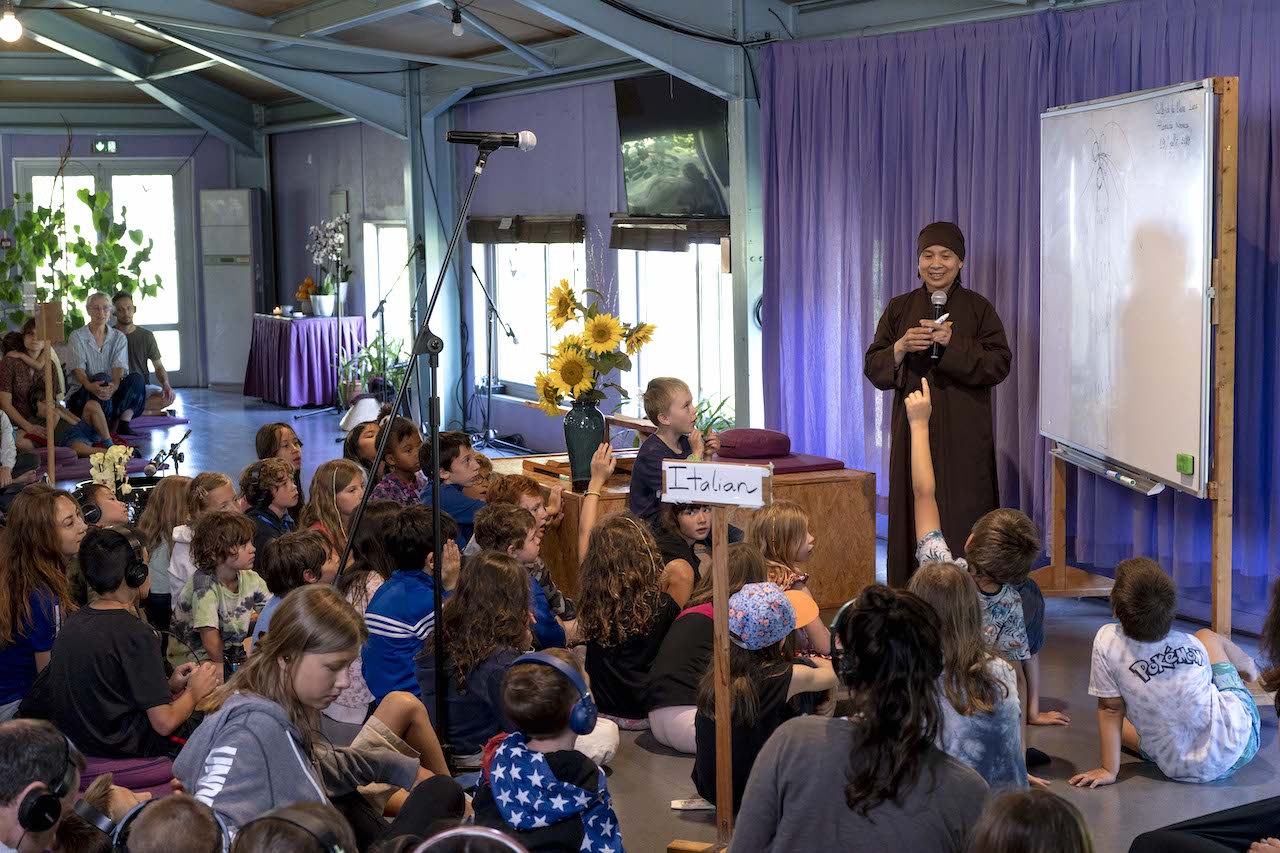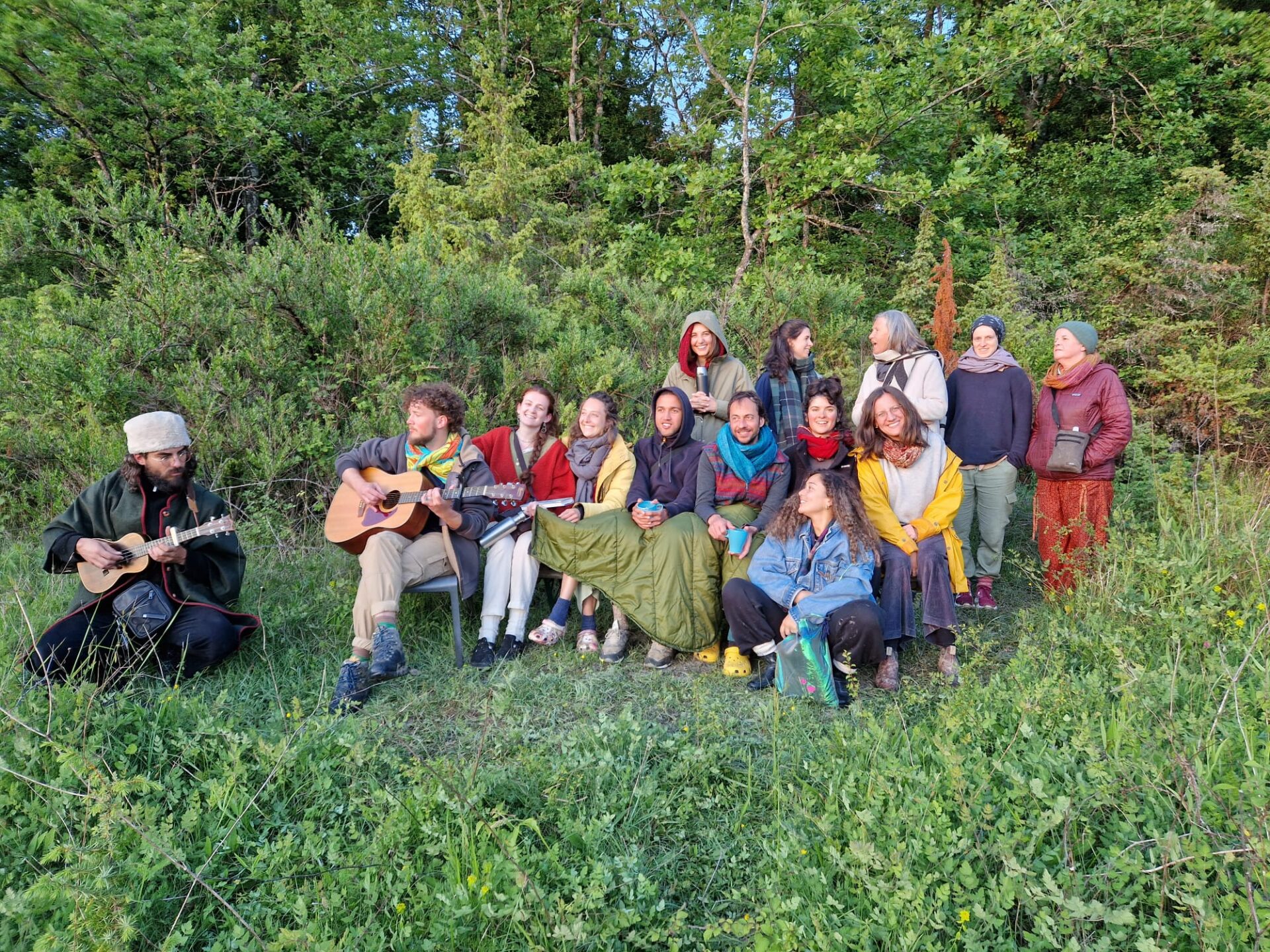Brother Phap Luu recollects impactful moments he has experienced with Thich Nhat Hanh since he first met Thay in 2001.
Like all of us writing here, thinking of Thay fills my heart with joy and peace. I remember the first talk I listened to at Maple Forest Monastery in 2001, with Sister Chan Duc translating. Thay taught about the role of the Care-Taking Council in Sangha life; here is a teacher thinking deeply about community, I thought! Sister Susan let me know that the next year, Thay was coming to Providence, Rhode Island. There, by the canal downtown, Thay seemed to burst out of a sea of brown monastics like a magician at the beginning of the walking meditation. Later that night, in the public talk, I remember listening to Thay while down on my knees in gratitude for his life and his capacity to teach the Dharma. I was blown away.
The following year, 2003, I sneaked out of the Stonehill Retreat to listen to Thay speak at the Boston Public Library. At the Q&A that followed the launch of Creating True Peace, Thay left time for questions. I walked up to the podium, and in front of hundreds of people – including my sister – asked Thay if I could become a novice. The audience burst out in laughter from the unexpectedness of the question, but Thay looked at me with solemnity. Thay said, “Thay only plays a ceremonial role in the novice ordination. The Sangha decides who ordains. To become a monk you should come to Plum Village, and live and practice in harmony with the community, and if the aspiration is correct…” At those words, Thay looked at me, and it felt as if my face were pressed into the torrential flow of a mountain waterfall, eroding away all my worries, anxiety and fear. Thay’s look penetrated to my bones. “…and if the aspiration is correct, you can ordain as a novice.” In the next month, I sent in my last paycheck to pay off the remainder of my debt from student loans, and boarded a plane to Paris.
A Group of Nuns in the Bookstore!
Thay loved telling the story of how I met the community, and told it many times while I was an aspirant: I was working in a bookshop in my college town when four of the monks came in, including Thay Phap Lac. It was as if the monks in the sutras I had been reading suddenly leapt off the pages to manifest in front of me. The following day, Sr. Huong Nghiem and other nuns visited the bookstore as well. I had forgotten to run an errand at the bank before opening the store, and I was a bit stuck about what to do. But I then realized – I have nothing to worry about! There’s a group of nuns in the bookstore! “I’ll be back in ten minutes,” I announced, as I headed out the door. They smiled and were content to watch over things until I returned.
“Just Look at Thay”
I felt so nervous the first time I attended Thay, following Thay back to Sitting Still Hut after the Dharma talk, and I tried to make myself – a tall Westerner – as small as possible in the corner between the kitchen and main room. Thay must have sensed my anxiety; when he came out from the kitchen, he laid the palm of his hand on the middle of my back. My whole body relaxed and felt at ease. Many times since then, when I have felt overwhelmed by an emotion, I just remembered Thay’s hand on my back and, I relax right away.
Once, when I accompanied an elder brother to massage Thay at the Hermitage, Thay pulled a Sanskrit copy of the Buddhacarita by Asvagosha off the shelf for me to read while the massage was going on. It is a complex poem, even for those who know a bit of Sanskrit, but thanks to Thay’s gesture I have come back to it numerous times through the years, learning from the passages on Siddhartha Gautama’s renunciation of sense pleasures.
I was the youngest monk to follow Thay to Vietnam in 2005. In Hanoi, one of the elder brothers told me to “just look at Thay” whenever I didn’t know what to do. This worked wonders to a young novice who had never been in Asia before.
One night, in the first week, we got off the bus in a town near the outskirts of Hanoi to visit a temple of a nun – a student of Thay who had been to Plum Village. The road was narrow leading to her temple, and the sun was setting; we would have to walk about one kilometer to arrive there. I felt anxious for Thay; everything was so new and unusual for me in Vietnam, and I feared that someone might hurt Thay. Walking close to Thay, though, I felt no fear. Thay had been through so much, and practiced so deeply, that he was not afraid of being hurt or dying. Whenever fear or anxiety comes up in me, I remember Thay’s fearlessness in that moment, as Thay led the delegation through the winding dark roads, and my fear dissolves.
Human Beings Who Need the Practice
In the fall of 2006, as I worked with Brother Phap Thanh from Germany to organize the first Neuroscience Retreat in Plum Village, we stopped at the Hermitage after arranging for the retreat flyer to be printed. Thay was in his short robe outside, walking in meditation amidst the fruit trees. When Thay looked at us – two tall Western monks – I saw him austere as the general of great armies. I had the perception that Thay was in deep contemplation on how to transform the suffering of the world – and here we were suddenly disturbing Thay’s contemplation! But Thay was so compassionate. We wanted to ask Thay if it was all right to invite scientists to come and present in the retreat. Thay said, “The scientists can come and practice with us, but they should not expect to present the papers they have already written. After a few days of practice, they can speak to us about the insight they have received during the retreat.” It was an important teaching for me: not to get caught up in someone’s renown as an important scientist or knowledge, but rather to see them as human beings who also need the practice.
Engaged Practice and Contemplative Life Are Not Two
The Dharma teachers of Upper Hamlet decided to send Br. Phap Ho and I to Deer Park Monastery that spring, and we said goodbye to Thay before leaving. Thay told us, “Do not try to find the balance between engaged practice and contemplative life. They are one.” In that moment, an obstruction in my thinking broke open, like a dam bursting. Since then I haven’t once fallen into the trap of thinking that my practice needs to be more engaged, or more contemplative. Thay revealed it for me as the dualistic thinking it is.
Proof of this came in the US Tour the following year – 2007 – when Br. Phap Dung and I presented the text of an Ecological Initiative that we had written for all of our centers. Deer Park was preparing to get solar panels, starting to drive cars that run off used vegetable oil, and had made the commitment to have a Car-Free Day once a week. When we read the text to Thay, Thay announced the Earth Peace Treaty – a commitment that people could make to themselves to reduce their impact on the environment. That night I drafted the first version of the Earth Peace Treaty Commitment Sheet, and Thay called me up after just about every talk and retreat in that tour to present it to the attendees and practitioners. Hundreds of people made commitments. I felt nervous to be getting so much attention from Thay on that tour, but I soon realized that, more and more, I was just an extension of the Sangha body. Thay was training me to see myself like that. Even now, when I give a talk and am up in front of people, I don’t feel nervous because I see that I am not separate from the Sangha body. I trust in Thay’s teachings, and let the ancestors do their work.
In 2008, on Thay’s last trip to India, one day Thay asked me to come with him to Motilal Banarsidass—a renowned Sanskrit bookstore in Delhi. I was touched by how joyful Thay was to walk with us amidst the ancient Buddhist texts in their original language. We made quite a pile of books for Dharmacarya Shantum Seth to help us buy at the register! Later on that trip, Thay was invited to be the guest editor of one day’s edition of the Times of India. Sister Pine, myself and others set up an impromptu editorial office in the business lounge of a Delhi hotel – one we had an event in but were not staying in – and worked all day to edit articles from lay friends on how to write a love letter to a terrorist. At that time there was growing violence between Muslims and Hindus, and a temple had been attacked. We went with Thay to the offices of the main editors of the Times, and they listened attentively to Thay as he taught them how journalists can bring peace to the world through their practice and writing.
When I returned to Plum Village in 2009, our young brothers and sisters had been expulsed from our Prajna Monastery in Vietnam, and I found myself thrust into the team working to get the word out about the situation. One day we were working in the Hermitage and Thay, with compassion for all of us, ordered us to sit at the kitchen table while he prepared scrambled tofu for us. Thay would not let us help him, and served us each individually. We were so moved at Thay’s humility. I realize now that Thay knew that we were doing things Thay could not do – and what he could do was offer us his love in a concrete way.
In a one-on-one meeting with Thay, Thay asked me to help him to write an opinion letter – on how to write a love letter to a terrorist – for the New York Times, by translating part of his talk on the Sutra on Fear and Terror. I felt so intimidated and reluctant to do it – how would I find a lay friend to help me translate? How would the New York Times agree to print such a letter? Now I see how my doubts did not give justice to Thay’s vision and insight. Although this letter did not happen in 2010, it did manifest in 2012 in a new form, when a young disturbed man in my hometown in the US killed 26 people in an elementary school – the Sandy Hook shootings. I felt that the horror of those shootings – happening in a place so dear to me – brought all of Thay’s teachings on non-violence together for me as I wrote the young man a love letter. Thay also asked me to work on the book Fear, but I didn’t yet feel ready to take on such a responsibility. Now, in 2022, having worked on a number of Thay’s books, I feel I am beginning to pay back my debt to Thay.

Guiding With Love and Care
I constantly received so much love and care from Thay, even when Thay corrected me – like the time I guided a meditation through all of the sixteen exercises of mindful breathing in one sitting session (and Thay said it was too much), or when we started streaming Thay’s talks and filmed pan shots of the audience (Thay said it was distracting people who wanted to concentrate on the talk). I am still learning how to give guidance to my younger brothers with as much care and love that Thay gave me.
In 2013, when the President of the World Bank Jim Kim invited Thay to speak there, I joined Thay to meet with Jim Kim, and was impressed at how Thay was considered a teacher even by such an important person. Jim Kim asked Thay for one hour of one-on-one teaching before the main events; I realized that it was difficult for a person like the President of the World Bank – in such a high-profile position- to get guidance from someone with wisdom he can totally trust. Afterwards, he put into practice what Thay taught him, and Thay told me to write to him to tell him that he was an excellent student.
One last story: For years the Spanish sangha had wished to invite Thay on a full tour in Spain, and finally, with Sister Thoai Nghiem’s help, Thay agreed to come in the spring of 2014. I was the main monastic organizer, together with Br. Phap Lieu; we did not imagine yet that it would be Thay’s last teaching tour.
Before going, I met with Thay to discuss a minor difficulty in organizing one of the public talks, and Thay said that the public talks were not necessary. “Thay only goes there to offer retreats, so that people can practice and get transformation and healing.”
Thay gave the first public talk in a theater on Gran Via, one of the main arteries of Madrid. The attendees were deeply moved by the talk, which was followed by Sister Chan Khong’s singing and a presentation of Thay’s calligraphies and books – some of which had been written in Spanish especially for this tour and were for sale.
A few days later, an article appeared in the largest newspaper, El Pais, titled The Lotus and the Euro, criticizing the commercial nature of this “spiritual enterprise” around Thay. The sangha in Spain, and I, were hurt by the article, which did not mention at all the charity work Thay and Sister Chan Khong had done throughout their lives. They also did not mention the public walk that Sister Chan Khong led, directly following the talk, from the Royal Palace in Madrid to a nearby park. To respond we organized, along with journalist friends in the sangha, a coordinated response, which included an interview with Thay on the “contra” or back page of the most prominent paper in Barcelona, La Vanguardia.
When I came to Thay to discuss the situation, Thay was resting in his hammock in the Catholic nunnery where we stayed in Barcelona. Thay saw my concern about the negative article as I explained to him why we had arranged for an interview. Thay looked at me with compassion from the hammock and said, “Thay doesn’t care about these things.” Suddenly, I felt a huge weight come off my shoulders. If Thay doesn’t care about negative press, why should I care about it?
I have continued to use this teaching and practice to help me take care of my emotions, and not to be too concerned about wrong perceptions others may have. Thay teaches me to come back to myself, and to do my best to practice. That is what I do until today.







Join the conversation